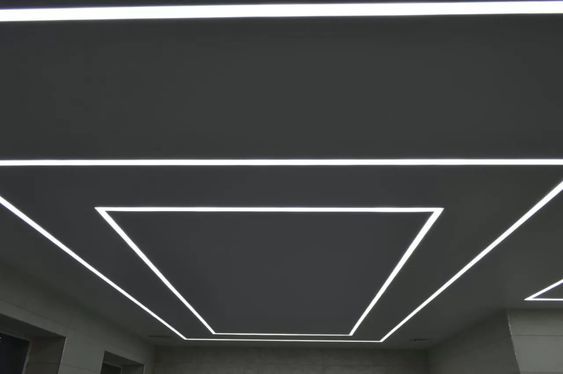Understanding Profile Lights
Profile lights have become a trend in modern interiors, and they offer a sleek and stylish look. However, installing them without a false ceiling presents some unique challenges. Let’s dive into how to achieve this without compromising the aesthetics of your ceiling.
Components of Profile Lights
A profile light is made up of five main components:
- Aluminum Casing: The foundation attached to the ceiling.
- Adapter: Supplies power to the LED light strip.
- LED Strip Light: The light source housed within the aluminum casing.
- Wiring: Connects the LED strip to the adapter and then to a switch.
- Switch: Controls the entire setup.
Each part plays a crucial role, and understanding how to install them correctly is key to a successful and clean setup.
Choosing the Right Aluminum Casing
Aluminum cases come in three main types:
- With Collar: Best used with false ceilings but not recommended for our application.
- U-Shaped Without Collar: Ideal for installations without a false ceiling.
- Corner Profile: Suitable for edges but not recommended for poorly finished ceilings, as the light can highlight imperfections.
Tip: For a non-false ceiling setup, go with the U-Shaped Without Collar Aluminum Case. Choose one with a depth of 6mm and a width of 7.2mm or 25mm, ensuring it doesn’t protrude too much from the ceiling.
Installation Process
Step 1: Marking the Ceiling
First, mark the areas where the profile lights will be installed. It’s crucial to measure accurately and use a straight edge to ensure the lines are even. Any misalignment can make the final installation look off and difficult to fix.
Step 2: Mounting the Aluminum Case
To secure the aluminum case:
- Use adhesive solutions like Aero Lite or a similar bonding agent on the back of the case.
- Reinforce with 1-inch gypsum screws. The combination of adhesive and screws will keep the case secure and prevent sagging, especially since LED strips can generate heat over time.
Important: Avoid relying solely on adhesive. The screws provide necessary support and prevent the case from bending or loosening over time.
Managing Corners and Angles
When the profile light needs to turn a corner, cut the aluminum case at a 45-degree angle to form a clean 90-degree joint. This method, known as “kalam cutting,” ensures a seamless look and prevents any gaps that might detract from the appearance.
Adapter Placement
Finding the right spot for the adapter is often the trickiest part. If you had a false ceiling, it would easily hide the adapter. Here’s how to work around this:
- Use High Furniture: Place the adapter on top of tall furniture like wardrobes or cabinets. This keeps it accessible and out of sight.
- Hidden Within Electrical Boxes: If possible, use an existing electrical or switch box to house smaller adapters.
- Behind Low Furniture: If tall furniture isn’t available, consider placing the adapter behind low furniture pieces like a bed or a study table.
Note: Make sure the adapter is easily accessible in case it needs to be replaced, as adapters are more likely to fail than the LED strips themselves.
Adapter Selection Guide
It’s crucial to choose a high-quality adapter from a reliable brand. Avoid cheap, local options, as these are prone to issues and could become the weakest link in your setup.
Power Calculation
- For 240 LEDs per meter, you’ll need 1 amp per half meter.
- For 120 LEDs per meter, 1 amp per full meter is sufficient.
Calculate the total length of your profile light and select an adapter with adequate power. For example, if you have 15 meters of 240 LED/m strip, you’ll need a 30-amp adapter.
Finishing Touches
Once the aluminum case and adapter are installed, connect the wiring, ensuring all connections are secure and hidden as much as possible. Use paint or spray to color-match the aluminum case if needed. For example, you can spray-paint a silver profile black for a custom look and leave it to dry thoroughly before installation.
Conclusion
Installing profile lights without a false ceiling is entirely feasible with the right tools and approach. It requires careful planning, precision, and the right choice of materials. With these steps, you can transform your room with beautiful profile lighting without needing to invest in a false ceiling.

